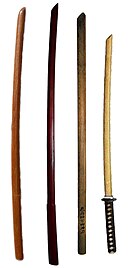Bokken
A bokken (木剣, bok(u), “wood”, and ken, “sword”) (or a bokutō 木刀, as they are instead called in Japan) is a Japanese wooden sword used for training. It is usually the size and shape of a katana, but is sometimes shaped like other swords, such as the wakizashi and tantō. Some ornamental bokken are decorated with mother-of-pearl work and elaborate carvings.
Bokken should not be confused with shinai, practice swords made of flexible bamboo.
History
Bokken were designed to lessen the damage caused by fighting with real swords and were used for the training of samurai warriors in feudal Japan. Bokken eventually became lethal weapons themselves in the hands of trained experts.[1]
Miyamoto Musashi, a kenjutsu master, was renowned for fighting fully armed foes with only one or two bokken. In a famous legend, he defeated Sasaki Kojiro with a bokken he had carved from an oar while traveling on a boat to the predetermined island for the duel. [2]
Usage
In 2003, the All Japan Kendo Federation (AJKF) introduced a set of basic exercises using a bokuto called Bokuto Ni Yoru Kendo Kihon-waza Keiko-ho. This form of practice is intended primarily for kendoka up to Nidan, but can be beneficial for all kendo students.
Suburito are bokken designed for use in suburi. Suburi, literally “bare swinging,” are solo cutting exercises. Suburito are thicker and heavier than normal bokken and users of suburito must therefore develop both strength and technique. Their weight makes them unsuitable for paired practice and kata. One famous user of the suburi-sized bokken is Miyamoto Musashi who used one in his duel against Sasaki Kojiro.
Bokken are currently (as of 2015) issued to the Los Angeles Police Mounted Unit for use as batons.[4][5]
Types of bokken
Bokken can be made to represent any style of weapon required such as nagamaki, no-dachi, yari, naginata, kama, etc. The most widely used styles are:
- daitō or tachi (katana-sized), long sword
- shoto or kodachi or wakizashi bo, short sword, (wakizashi-sized)
- tantō bo (tantō-sized)
- suburito can be made in daitō and shoto sizes
Additionally, various koryu (traditional Japanese martial arts) have their own distinct styles of bokken which can vary slightly in length, tip shape, or in whether or not a tsuba (hilt guard) is added.
The All Japan Kendo Federation specify the dimensions of bokken for use in the modern kendo kata, called Nippon kendo kata.[6]

